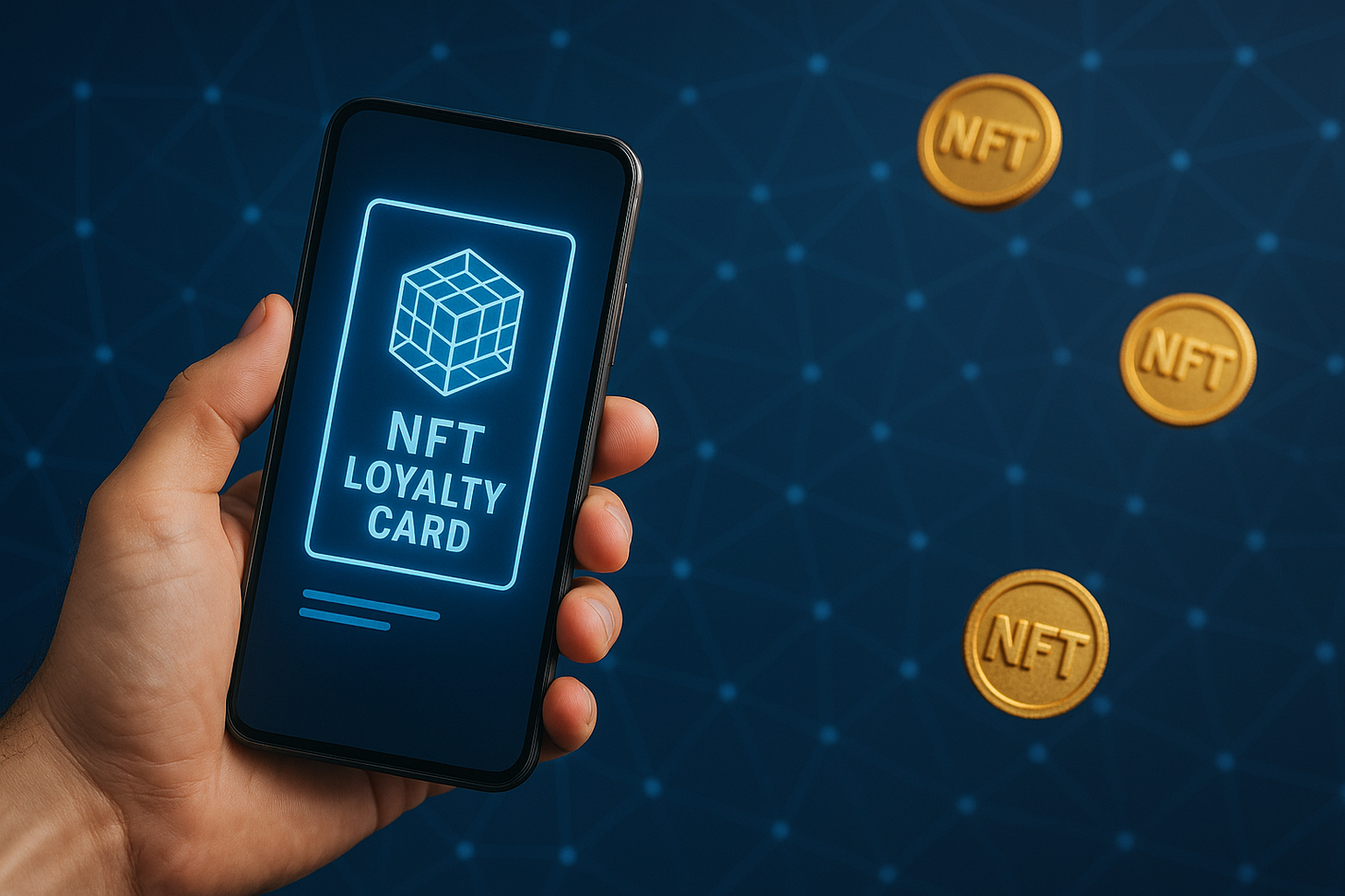In an era where customer attention is fleeting and brand loyalty is more fragile than ever, traditional loyalty programs are losing their appeal. Punch cards, static point systems, and generic discounts no longer excite or retain customers the way they once did. To survive and thrive in this new landscape, brands must innovate. Enter NFT loyalty programs, a blockchain-based revolution in how businesses engage, reward, and retain their customers.
These programs go beyond transactional incentives. They harness the power of non-fungible tokens (NFTs) to create unique, personalised, and tradable digital experiences that foster long-term customer relationships and emotional brand engagement.
Table of Contents
What Are NFT Loyalty Programs?
An NFT loyalty program is a customer engagement strategy where participants earn non-fungible tokens—unique digital assets stored on a blockchain—as rewards for their interaction with a brand. These interactions may include purchases, referrals, social engagement, event participation, or brand advocacy.
Unlike conventional loyalty points, NFTs:
- Cannot be duplicated
- Have built-in rarity and uniqueness
- Can be traded, transferred, or sold
- Often come with attached utility, like access to VIP events, early product releases, or exclusive content.
NFTs also offer customers a sense of true digital ownership—a central differentiator that transforms customer-brand dynamics from passive participation to active, emotional investment.
How NFT Loyalty Programs Work
Let’s break down a typical NFT-based loyalty journey:
1. Customer Engagement
Users interact with the brand in specific ways—buying a product, completing a challenge, or referring a friend.
2. NFT Issuance
The customer receives a digital token minted and stored on a blockchain. This may be done automatically through a smart contract, often via a simple mobile interface or app.
3. Utility and Benefits
NFTs can unlock a variety of rewards, such as:
- Discounts
- Exclusive product access
- Event invitations
- Gamified experiences
- Entry into community platforms
4. Secondary Value
Since NFTs are non-fungible and tradeable, users can also resell them on secondary markets, adding an extra layer of value that traditional points systems can’t offer.
5. Long-Term Engagement
Customers may be incentivised to collect sets, reach new tiers, or engage in NFT-based missions, keeping them connected to the brand longer.
Key Features of NFT Loyalty Programs
1. Digital Ownership
The most groundbreaking aspect of NFT loyalty programs is the transfer of ownership. Traditional loyalty points are controlled and limited by the issuing brand—they expire, cannot be transferred, and are often restrictive.
In contrast, NFTs:
- Are owned outright by the user
- Exist independently of the brand
- Can be verified on the blockchain
- May increase in value over time
This ownership gives customers pride and autonomy in their loyalty experience, making them feel more deeply connected to the brand.
2. Personalisation and Exclusivity
NFTs can be customised to reflect individual customer behaviour and status. Brands can create:
- Tiered NFTs based on spending or engagement level
- Dynamic NFTs that evolve based on user activity
- Exclusive drops for high-value customers
This level of personalisation gives customers a sense of status and appreciation, transforming loyalty into a more emotional and social experience.
3. Enhanced Engagement Through Gamification
One of the most powerful tools in marketing is gamification, and NFTs offer the perfect infrastructure for it.
Brands can build:
- Quests and challenges that reward users with rare tokens
- Achievement badges for completing milestones
- NFT-based games that blend entertainment with loyalty
The result? Increased interaction frequency, longer user lifecycles, and a more memorable brand experience.
4. Community Building and Social Identity
NFTs can be used as membership passes to digital or in-person communities. They act as keys to special experiences and exclusive groups, offering social validation and insider access.
Examples include:
- Private Discord or Telegram groups
- Invite-only product launches
- Access to brand AMAs or livestreams
This social layer of loyalty is hard to replicate with traditional programs and can turn casual customers into brand evangelists.
5. Interoperability Across Platforms
Unlike point systems that are confined within a single ecosystem, NFTs are interoperable. They can be recognised and honoured across multiple platforms and brands through blockchain partnerships.
For example:
- A beauty NFT could offer discounts at skincare partner brands
- A music NFT might grant access to a range of live shows
- Travel NFTs could integrate with hotels, airlines, and tour operators
This creates a coalition of value that benefits both the customer and the participating brands.
Why Brands Are Embracing NFT Loyalty Programs
1. Higher Engagement Metrics
Brands that implement NFT loyalty strategies often report dramatic improvements in customer metrics:
- 30% increase in user engagement
- 50% improvement in customer retention
- Greater shareability and social buzz
NFTs tap into emotional loyalty, not just transactional loyalty, encouraging users to stay connected beyond immediate incentives.
2. Rich Data and Behavioural Insights
Every NFT transaction on a blockchain is recorded, public, and transparent, enabling brands to:
- Understand purchase behaviour
- Track engagement trends
- Identify top customers and superfans
- Create dynamic customer personas
This kind of real-time, reliable data gives businesses a major edge in personalising campaigns and allocating marketing resources effectively.
3. Market Differentiation and Brand Innovation
Adopting an NFT-based loyalty program signals that your brand is:
- Forward-thinking
- Tech-savvy
- Committed to customer experience innovation
In crowded markets, this kind of strategic differentiation can lead to more media attention, influencer engagement, and customer intrigue.
4. Appeal to Digital-Native Consumers
Millennials and Gen Z consumers, who make up a growing portion of global spending, are more likely to value:
- Digital ownership
- Personalisation
- Tech-forward experiences
- Community-based interactions
NFT loyalty programs align perfectly with these expectations, helping brands to connect authentically with younger demographics.
5. Resale Value and Extended Brand Reach
NFTs can be resold on open marketplaces, which introduces an entirely new dynamic: your loyalty program becomes a marketing engine.
- Buyers of secondhand NFTs discover your brand
- Sellers, extend your brand exposure
- Exclusive NFTs create viral scarcity events
Even customers who are no longer actively engaging may still contribute to brand awareness through NFT activity.
How to Implement an NFT Loyalty Program
Launching a successful NFT loyalty program requires a thoughtful strategy that considers both technology and customer experience. Below is a detailed breakdown of the key steps brands should follow.
1. Define Clear Objectives
Start by identifying the goals of your loyalty program. These could include:
- Increasing repeat purchases
- Enhancing brand engagement
- Collecting valuable user data
- Building a digital community
- Attracting younger, tech-savvy consumers
The success of your NFT initiative hinges on clear objectives that align with your overall business strategy.
2. Choose the Right Blockchain Platform
Selecting the appropriate blockchain is crucial. Key factors include scalability, transaction fees, and environmental impact. Some popular options:
- Ethereum: Highly established, but has higher gas fees
- Polygon: Low-cost and energy-efficient, popular for NFT applications
- Solana: Fast transactions and low fees, but a younger ecosystem
- Flow: Designed specifically for consumer-friendly NFT experiences
The right platform depends on your target audience, technical resources, and desired user experience.
3. Design Meaningful and Appealing NFTs
The value of an NFT in a loyalty program lies in its design, utility, and exclusivity. Consider the following:
- Visual Appeal: NFTs should look unique, branded, and desirable
- Rarity Levels: Introduce scarcity to drive competition and engagement
- Functionality: Attach tangible benefits—event passes, discounts, VIP perks
- Collectibility: Create themes or sets that encourage users to collect them all
Customers are more likely to engage with NFTs that are visually distinctive and emotionally resonant.
4. Develop and Audit Smart Contracts
Smart contracts automate the issuance, transfer, and redemption of NFTs. These should be:
- Secure: Vulnerabilities can lead to hacks or loss of assets
- Efficient: Ensure smooth and reliable user interaction
- Transparent: Rules for earning or redeeming NFTs should be clearly coded
Work with experienced blockchain developers to test and audit your smart contracts before deployment.
5. Integrate with Existing Loyalty Systems
NFTs should complement—not replace—your existing CRM or rewards infrastructure. Ensure:
- NFT earnings are tied to traditional loyalty metrics
- Users can connect wallets easily via existing apps
- Redeeming NFTs for benefits is intuitive and rewarding
A seamless experience increases adoption and reduces friction for customers unfamiliar with Web3 technology.
6. Educate Your Customers
One of the largest hurdles in adopting NFT loyalty programs is the lack of consumer familiarity. Provide:
- Tutorials on setting up a digital wallet (e.g., MetaMask, Coinbase Wallet)
- In-app or email walkthroughs on how to claim, store, and use NFTs
- Support via chatbots or customer service teams
The easier the process, the higher your engagement rate.
7. Launch a Pilot Program
Instead of a full-scale rollout, begin with a pilot program to gather feedback. This allows you to:
- Test user experience flows
- Measure engagement and redemption rates
- Understand common pain points
- Adjust smart contracts or design elements before full deployment
Iterate quickly based on feedback to improve the program before scaling.
Challenges and Considerations
Despite the tremendous promise, NFT loyalty programs come with a set of challenges that brands must navigate thoughtfully.
1. Technical Complexity
Blockchain development, wallet integrations, and smart contract creation all require specialised knowledge. Most businesses don’t have this expertise in-house and must partner with Web3 developers or agencies.
To mitigate this:
- Use NFT-as-a-Service platforms
- Start with low-code blockchain solutions
- Consider using custodial wallets to eliminate friction
2. Customer Education and Adoption
For many consumers, NFTs remain a confusing or intimidating concept. Brands must balance innovation with accessibility. Solutions include:
- Offering NFTs without requiring crypto knowledge
- Using email-linked wallets or single sign-on options
- Creating mobile-friendly, Web2-style experiences
Education is key. Even short videos or infographics can dramatically reduce barriers to entry.
3. Regulatory Uncertainty
NFTs live in a grey area in many jurisdictions. Legal concerns may include:
- Securities laws (if NFTs are seen as investments)
- Tax implications for reselling NFTs
- Data privacy laws tied to wallet-based user behaviour
It’s critical to consult legal counsel to stay compliant with evolving laws in each target region.
4. Environmental Impact
Some blockchains have been criticised for high energy use. Ethereum, for example, has reduced its carbon footprint significantly after shifting to proof-of-stake, but brands must still consider sustainability.
To align with eco-conscious consumers:
- Use energy-efficient blockchains like Polygon, Tezos, or Solana
- Offset emissions via carbon credits
- Publicly disclose environmental practices
5. Balancing Exclusivity and Inclusivity
While exclusivity drives desirability, it shouldn’t come at the cost of excluding large parts of your customer base. Avoid:
- Over-pricing access
- Limiting participation to high-spending users
- Making NFT redemption overly technical
Instead, offer a range of tiers so both casual users and brand superfans can participate meaningfully.
Future Outlook: Where NFT Loyalty is Headed
As both technology and consumer understanding evolve, NFT loyalty programs are expected to become more dynamic, more accessible, and more powerful.
Here are five predictions shaping the future:
1. Mass Adoption Through Web2 Integration
Mainstream platforms like Instagram, Shopify, and Reddit are integrating NFTs into their ecosystems. This paves the way for:
- In-app wallet creation
- NFT storefronts embedded in social platforms
- Easier on-ramps for everyday consumers
As Web2 platforms embrace Web3 tech, the adoption curve will flatten, bringing NFT loyalty into the mainstream.
2. Cross-Brand Loyalty Ecosystems
Expect to see coalitions of brands offering shared NFT programs. For instance:
- A sports brand, energy drink company, and fitness studio offering interoperable loyalty NFTs
- Travel brands (airlines, hotels, tour operators) are pooling rewards into one NFT-based passport
- Musicians and venues issuing NFTs for concert perks, backstage access, and fan club entry
This creates network effects that drive value and stickiness across ecosystems.
3. Dynamic and Evolving NFTs
Future NFTs will change over time based on customer behaviour. For example:
- A base-tier NFT that evolves into a premium one after 10 purchases
- An NFT that unlocks seasonal offers based on engagement frequency
- Digital collectables that grow or animate the longer they are held
These create a living relationship between the customer and the brand.
4. AI-Powered Personalisation
AI tools will analyse blockchain behaviour and user interactions to deliver hyper-personalised NFTs, including:
- Custom designs or messages
- Recommended perks based on past behaviour
- Real-time, AI-curated experiences for NFT holders
This adds a layer of smart engagement that adapts over time, making the loyalty program more responsive and meaningful.
5. Decentralised Governance and Community Co-Creation
Eventually, NFT programs may adopt DAO-like structures (Decentralised Autonomous Organisations), allowing users to:
- Vote on new reward tiers
- Co-create product designs
- Influence brand campaigns or charity contributions
This democratises loyalty, making customers active participants rather than passive consumers.
Final Thoughts
NFT loyalty programs are redefining the way brands connect with their customers in a digital-first world. By leveraging blockchain technology and the unique characteristics of non-fungible tokens, businesses can move beyond traditional points-based systems and create a more engaging, personalised, and emotionally resonant customer experience. The concept of digital ownership, coupled with exclusivity and community, transforms passive consumers into active participants and brand advocates.
The ability for customers to truly own their rewards, whether in the form of digital collectables, access passes, or utility-driven tokens, creates a new sense of value that traditional systems cannot match. NFTs introduce scarcity, tradability, and real-world utility, making each reward more than just a fleeting perk. This fundamental shift turns loyalty into something customers can collect, showcase, or even monetise, thereby deepening their connection with the brand.
For businesses, the advantages extend well beyond customer satisfaction. NFT-based programs provide access to transparent and actionable data, help differentiate brands in crowded markets, and appeal to younger, tech-savvy audiences who value authenticity and innovation. Moreover, the potential for interoperability and cross-brand collaboration paves the way for more expansive and scalable loyalty ecosystems.
Despite the challenges, ranging from technical complexity and regulatory considerations to customer education and accessibility, the long-term benefits of NFT loyalty programs are significant. As the technology matures and tools become more user-friendly, the barriers to adoption will diminish, enabling more brands to harness the power of NFTs effectively.
Ultimately, NFT loyalty programs represent not just a trend but a glimpse into the future of customer engagement. They blend technology, community, and creativity in a way that reimagines how loyalty is earned, experienced, and rewarded. For brands looking to build meaningful, lasting relationships in an increasingly digital world, embracing this innovative model may soon become not just an advantage but a necessity.






